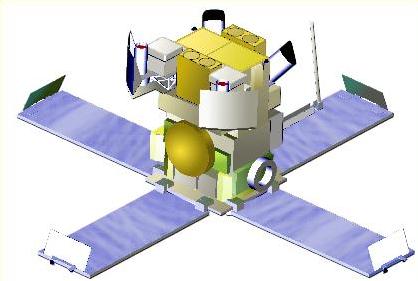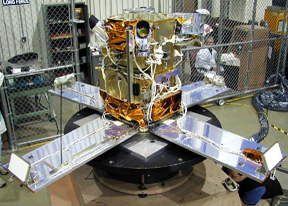Imagine the Universe News - 10 October 2000
Dishwasher-shaped Satellite to Catch Gamma-Ray Bursts
| 10 October 2000 |

Now there's a satellite dedicated to addressing the gamma-ray burst mystery. The High Energy Transient Explorer (HETE-2), launched on October 9, will track these powerful flashes of light and relay their location to scores of ground-based and orbiting telescopes in hopes to learn more about the bursts' source.
 HETE-2 on the Pegasus Rocket at Vandenberg AFB |
This is no easy task. The bursts can appear from any direction without warning and may last for only a few milliseconds to just over a minute. Scientists can seldom get a good look before the bursts fade away, never to return in the same location. These bursts may be from merging black holes and neutron stars or perhaps the explosions of extremely massive stars; all come from very far distances.
HETE-2, roughly the size and shape of a dishwasher, has one special advantage over all other satellites: it's fast and it has connections. Within seconds, HETE-2 can spot a burst and notify other observatories with a rough location. Within minutes, HETE-2 may obtain a precise location. The craft will detect dozens of bursts a year and, for about 30 of these bursts, provide very detailed information about their location and spectra, or light characteristics.
With such agility, HETE-2 will also observe star systems that suddenly flare with little or no warning. These include stars orbiting either a black hole or a neutron star. For relatively steady sources, HETE-2's superior sensitivity will lead to the discovery of many new X-ray pulsars and Soft Gamma Ray repeaters.
In observing such diversified phenomena, HETE-2 covers a large swath of the electromagnetic spectrum. The three instruments aboard HETE-2, in fact, detect a range hundreds of times wider than an optical telescope -- from low-energy (or soft) X rays through high-energy (or hard) X rays and into gamma ray energies.

|
The French Gamma Telescope (FREGATE), built by Centre d'Etude Spatiale des Rayonnements (CESR), will detect the gamma-ray bursts and very bright (higher energy) X-ray transients. The Wide-Field X-ray Monitor (WXM), built by Japan's Institute of Physical and Chemical Research (RIKEN) and Los Alamos National Laboratory, detects light slightly lower in energy. The WXM therefore will detect fewer gamma ray bursts than FREGATE, but because of its superior resolution, it will be able to locate the FREGATE-detected bursts to within an arc minute. The Soft X-ray Camera (SXC), built by Massachusetts Institute of Technology, is ideal for detecting lower-energy X-ray transients, such as neutron stars.
Primary and Secondary Ground Stations, funded by several organizations, contribute to HETE-2's strength by transferring HETE-2 data and notifying observatories around the world and in space about active bursts. HETE-2 will also tap into the Gamma-Ray Burst Coordinates Network, an established burst relay system built and operated by NASA Goddard Space Flight Center.
HETE-2 replaces the original HETE, which was lost to a rocket launch failure in November, 1996. The mission principal investigator is Dr. George R. Ricker of MIT; the project scientist is Dr. Thomas Cline at Goddard. The satellite was assembled at MIT and launched from Kwajalein Missile Range on a Hybrid Pegasus.

